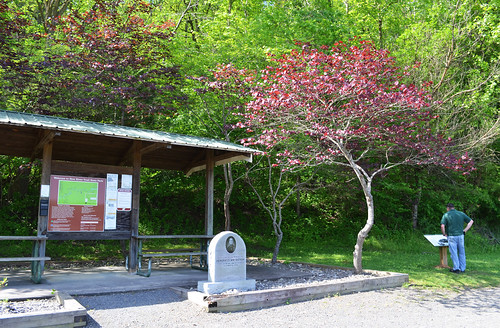Read Our Blogs
Stories from the Trail: Fincastle County and Independence
Shared by Zachary Hubbard, as Guest Blogger.
Nestled along New River Trail State Park’s fifty-seven miles lies a community that has seen the beginning of colonization, the Revolutionary War, and the Civil War. This community is known by its modern-day name of Austinville, which was also known for its mining materials found in its limestone. The Lead Mines were first discovered by Col. John Chiswell in the 1750s. Chiswell and his partners opened the first mines in 1761 as new settlements began to move to the area.

The population grew as more settlers came, to a point where a new county was needed to properly govern and protect the people’s interests in the new frontier. In 1772, Fincastle County was established, cutting away from Botetourt County. It stretched from Southwestern Virginia into the area that would become Kentucky. A new governing body made by representatives voted on and appointed from all corners of the county. Some would serve on the first-ever Committee of Safety, which was dedicated to protecting the land from Native American attacks and upholding the laws of the land.
The Lead Mines would become the new county seat, providing lead used by farmers, settlers, and the militia. The courthouse would be the meeting area for the county. The Committee of Safety wrote laws for the county and was a representative of their respective home areas throughout the Blue Ridge and Appalachia. In 1775 the Committee of Safety met to discuss the most important topic of the Colonies of America: To support England or to fight as part of the future United States

On January 20, 1775, the men of the Committee of Safety gathered at the Lead Mines to discuss the treatment of the colonies, the views of their fellow state’s men, and how we as a nation should abide. They drafted a document with their thoughts and ideas on the issue of British rule to be delivered to the First Continental Congress in Philadelphia.
This document would become the Fincastle Resolutions. Like others, Fincastle agreed to stay loyal to the British Crown as long as their right as free citizens of Virginia were not interfered with, such as new taxes by Parliament without just representation and the mistreatment of the Northern Colonies for their participation in the Boston Tea Party.
It was this document that finally said the words that everyone was thinking and was too afraid to say until now. Though the people of Fincastle wanted to stay under British rule, if their demands were not met, they were prepared to fight to ensure their rights as Americas and Virginians in the new United States of America.
The document arrived at the First Continental Congress weeks later and was read to the Virginia Delegates and later the entire assembly. George Washington who was then a Delegate of Virginia and Commander and Chief of the Continental Army said, “Strip me of the dejected and suffering remnant of my army; take from me all that I have left; leave me but a banner; give me but the means to plant it upon the mountains of West August [Areas stretching from Augusta County, Fincastle County, and throughout the mountains of Virginia and West Virginia], and I will yet draw around me the men who will lift their bleeding country from the dust and set her free.”
Those who were still on the fence began to move towards the side of freedom as more and more citizens were inspired to fight British rule. These thoughts would continue to echo through the minds of Americans, leading to the signing of the Declaration of Independence just a year and a half later.
As the country began the true fight for independence in 1776, Fincastle County was forced to break up into Montgomery, Washington, and Kentucky Counties (later to become the state of Kentucky). Though it had a short history, this county made one of the biggest impacts on the country. The new counties that would take its place would bear the names of some of the men that were inspired by the Fincastle Resolution’s words and would go on to fight for our new country such as Carroll, Pulaski, Wythe, and Grayson, all of which can be visited along New River Trail State Park.

Resources-
Preston, T.L. (1900). Historical Sketches and Reminiscences of an Octogenarian. Richmond, VA: B.F. Johnson publishing. http://books.google.com/books?id=sTkSAAAAYAAJ&printsec=frontcover#v=onepage&q&f=false
Maps-
“Atlas of Historical County Boundaries.” Atlas of Historical County Boundaries Project, The Newbery Library, https://publications.newberry.org/ahcbp/index.htm
If you have read the article and have a question, please email nancy.heltman@dcr.virginia.gov.
Search for blogs
By Park
Categories
Cabins
Camping
Fishing
History and Culture
Other
Programs and Events
Trails
Volunteers
Water Fun
Archive
2024
2023
2022
2021
2020
2019
2018
2017
2016
2015
2014
2012














